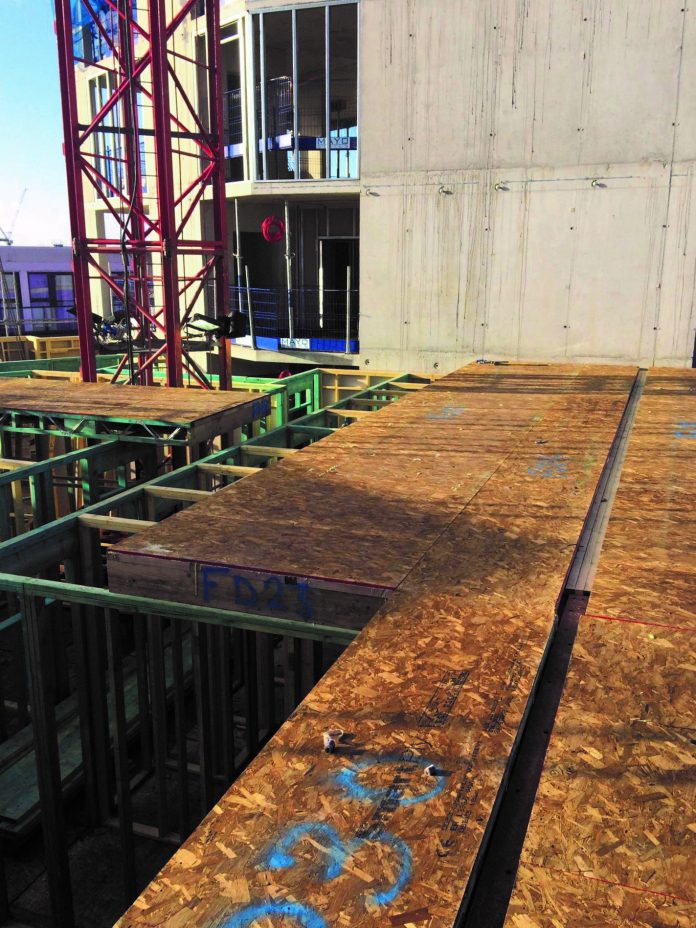As the construction industry gets back to work, there is an opportunity to put a renewed focus on building safety for both workers and occupants, says MEDITE SMARTPLY sales director Richard Allen
“Stop the spread” – a phrase that has been all but inescapable so far in 2020: all over our TV screens, blaring from our car radios and permeating so much of our lives as to influence most, if not all, of our activity every time we leave our homes.
But what about inside our homes? In the construction industry, these three words have been critically considered long before this year made them infamous, in relation to an issue that will continue to always be a top priority throughout the rise and fall of other considerations: fire safety.
In construction, safeguarding building occupants against the risk and spread of fire is paramount.
Demonstrating this, the UK government is prioritising the reform of building safety legislation with fundamental changes to the regulatory system for buildings. In the evolving construction industry we work in, these changes will impact the way the industry selects materials, designs and constructs buildings and even the way it manages them over the course of the buildings life.
The catalyst for this was, of course, the Grenfell fire tragedy in the summer of 2017. Following this, Dame Judith Hackitt was appointed by the government to undertake an independent review of Building Regulations and fire safety. Her review found that the systems used to design buildings in the UK were not fit for purpose and required a fundamental overhaul. The immediate focus of her review was the fire safety of residential buildings, and high-rise buildings in particular. However, many of the recommendations will impact fire and structural safety across the whole of the built environment.
There has always been a certain level of responsibility on manufacturers of construction products to allow and enable construction professionals to build safer, better buildings. However, with the call for a new era of accountability that was a key outcome of Dame Judith’s report, this is now more important than ever -especially when it comes to timber buildings or buildings which include timber products as part of the design.
The brink of a revolution
It has taken three years since the tragedy for the draft Building Safety Bill to be published, in July 2020. In the intervening time, construction has continued to evolve, and arguably its brief shut down in April 2020 due to the still ongoing Covid-19 pandemic has only spurred further change.
If construction was on the brink of a revolution over the last three years, it most certainly is in 2020. The steady rise in building techniques that fall within the brackets Modern Methods of Construction (MMC), notably offsite and timber frame construction, have gained further ground across the UK in response to the need for more efficient, more precise and more reliable processes that aim to also transfer these qualities to finished buildings.
Offsite methods, with all their factory-controlled rigor and minimised need for people on-site, in comparison to traditional building, has all but been hailed as the answer to construction in the time of coronavirus. Pressure to be sustainable and as environmentally friendly as possible has also had influence.
Taking all these elements into account, it can be predicted that the role of structural timber panels such as OSB can only continue to grow. Therefore, ensuring that all timber panels manufactured are high quality products, with clear labelling and a proven performance, especially for applications where reaction to fire is vitally important, is invaluable.
Timber panel innovations
Recent innovations such as flame-retardant (FR) OSB panels have opened up further possibilities which can allow these industries to benefit our wider construction agenda even more so, in terms of allowing increased productivity, attention to sustainability, waste reduction and address the need for reliable fire safety.
The latest innovation in this field is SMARTPLY MAX FR B.
Developed by specialist timber panel manufacturers MEDITE SMARTPLY, SMARTPLY MAX FR B achieves a reaction to fire rating of Euroclass B – the maximum Euroclass rating for a timber panel – for increased safety and reliability in an industry contingent on safety and predictability. This is the first Euroclass B board manufactured in the UK and Ireland to feature wood flakes treated with flame retardant solution before pressing into panel form.
Making its flame retardance integral and unchangeable by cutting or machining in this way demonstrates a simple innovation that responds in a practical way to the Hackitt report’s call for accountability and clear demarcation of safety and risk throughout the design and construction of buildings.
For the designers of timber buildings, and as previously mentioned for the product manufacturer catering to the designer, there is a responsibility to specify materials, and to provide details that reduce fire ignition potential, limit fire spread and stop the passage of smoke and other hot gases. An appropriately designed building will allow people who are remote from the source of fire to escape and provide a building from which the fire services can deal with the fire safely and effectively.
Structural fire safety is achieved by “passive” protection, eg flame retardant panels, for which SMARTPLY MAX FR B may be used, with “active” protection being ventilation, alarms and sprinklers. For structural engineers, the choice of structural solution materials will influence the passive fire protection strategy. The Euroclass, here Euroclass B, denotes the products robustness against fire ignition and in the load bearing resistance under fire time duration.
SMARTPLY MAX FR B contributes toward the safety for the eventual building occupant in the event of fire through the use of ZeroIgnition® technology: an environmentally friendly, water-based, flame-retardant solution. Applying this before pressing sets this panel apart from others that are treated post-manufacture in that it also protects against the destructive effects post-treating can have on the physical strength properties of OSB – on top of invalidating the CE mark if the board is ever cut.
The CE mark, under the Construction Products Regulation, means that a product’s fire safety is now an essential aspect of the Declaration of Performance of the product. Manufactured to meet European reaction to fire class B-s2, d0 and BFL -s1, SMARTPLY MAX FR B will maintain its CE mark for both fire safety standards and certified structural performance, so there is no room for doubt.
SMARTPLY MAX FR B also complies with the performance requirements in the Structural Timber Association’s FR BUILD Design Guide to Separating Distances During Construction for timber frame buildings above a 600m² total floor area. We refer to this product as SMARTPLY MAX FR/FR BUILD within our range.
SMARTPLY MAX FR/FR BUILD can be used in a timber frame building when mitigation measures are required due to the distance from neighbouring buildings. There are wall and floor systems outlined within the guide which give points towards the overall building; this satisfies any mitigation that may be required. Please refer to the STA guide for more information.
Finally, SMARTPLY MAX FR B also makes efforts to rise to the scale demands of offsite construction, in that it is able to be manufactured in sizes of up to 2.8m wide by 7.5m long.
This is made possible through a system called ContiRoll® – the continuous pressing of wood strands. This makes each board ideal not only for quality traditional building on the double but also for uses within offsite building. Large format panels also have the crucial to 2020 advantage of allowing output to remain constant with fewer people on site and letting individual workers maintain safe working distances between each other, adhering to government guidelines to indeed “stop the spread”.
After the hiatus earlier in 2020, the UK construction industry has an opportunity to restart with a fresher outlook, truly building for the future with a renewed focus on safety, for both building occupants and construction professionals. This is something that should be central to the development of timber panel solutions that aim to cater to fire safety, whatever the method of construction they will eventually be used within, as it has been with SMARTPLY MAX FR B.
For more information please click here.
Richard Allen
Sales director
Please note: this is a commercial profile.














